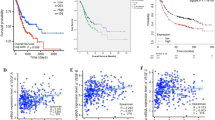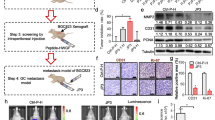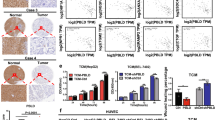Abstract
Purpose
Pancreatic cancer is characterized by a dense desmoplasia stroma, which hinders efficient drug delivery and plays a critical role in tumor progression and metastasis. MLN4924 is a first-in-class NEDD8-activating enzyme inhibitor that exhibits anti-tumor activities toward pancreatic cancer, and given the comprehensive effects that MLN4924 could have, we ask what impact MLN4924 would have on the stroma of pancreatic cancer and its underlying mechanisms.
Methods
Primary pancreatic stellate cells (PSCs) and human HMEC-1 cells were treated with MLN4924 in vitro. The proliferation and extracellular matrix protein levels of PSCs were tested, and their relationship with transcription factor Gli1 in PSCs was investigated. The angiogenic phenotypes of HMEC-1 cells were evaluated using capillary-like tube formation assay, and their relationship with REDD1 in HMEC-1 cells was investigated.
Results
In this study, we found that MLN4924 inhibited the proliferation of pancreatic stellate cells and their secretion of collagen and CXCL-1, and the collagen secretion inhibiting effect of MLN4924 was related with transcription factor Gli1. MLN4924 inhibited multiple angiogenic phenotypes of HMEC-1 cells, and mTOR agonist partially relieved the inhibition of MLN4924 on HEMCs. MLN4924 increased the expression of REDD1 and REDD1 knockdown promoted the angiogenic phenotypes of HMEC-1 cells.
Conclusions
Our study suggests that MLN4924 inhibits both the tumor stroma and angiogenesis in pancreatic cancer, and the inhibition effect is related with Gli1 in pancreatic stellate cells and REDD1 in vascular endothelial cells, respectively.





Similar content being viewed by others
Data Availability
The datasets generated and analyzed during the current study are available from the corresponding author on reasonable request.
References
Mizrahi JD, Surana R, Valle JW, Shroff RT. Pancreatic cancer. The Lancet 2020;395:2008–2020. https://doi.org/10.1016/S0140-6736(20)30974-0.
Sung H, Ferlay J, Siegel RL et al. Global cancer statistics 2020: GLOBOCAN estimates of incidence and mortality worldwide for 36 cancers in 185 countries. CA Cancer J Clin 2021;71:209–249.
Conroy T, Desseigne F, Ychou M et al. FOLFIRINOX versus Gemcitabine for Metastatic Pancreatic Cancer. N Engl J Med 2011;364:1817–1825. https://doi.org/10.1056/NEJMoa1011923.
Von Hoff DD, Ervin T, Arena FP et al. Increased Survival in Pancreatic Cancer with nab-Paclitaxel plus Gemcitabine. N Engl J Med 2013;369:1691–1703. https://doi.org/10.1056/NEJMoa1304369.
Amrutkar M, Gladhaug IP. Pancreatic cancer chemoresistance to gemcitabine. Cancers 2017;9:157.
Apte M, Park S, Phillips P et al. Desmoplastic reaction in pancreatic cancer: role of pancreatic stellate cells. Pancreas 2004;29:179–187.
Biffi G, Oni TE, Spielman B et al. IL1-induced JAK/STAT signaling is antagonized by TGFβ to shape CAF heterogeneity in pancreatic ductal adenocarcinoma. Cancer Discov 2019;9:282–301.
Hessmann E, Patzak M, Klein L et al. Fibroblast drug scavenging increases intratumoural gemcitabine accumulation in murine pancreas cancer. Gut 2018;67:497–507.
Yoshida N, Masamune A, Hamada S et al. Kindlin-2 in pancreatic stellate cells promotes the progression of pancreatic cancer. Cancer Lett 2017;390:103–114.
Qian D, Lu Z, Xu Q et al. Galectin-1-driven upregulation of SDF-1 in pancreatic stellate cells promotes pancreatic cancer metastasis. Cancer Lett 2017;397:43–51.
Rhim AD, Oberstein PE, Thomas DH et al. Stromal elements act to restrain, rather than support, pancreatic ductal adenocarcinoma. Cancer Cell 2014;25:735–747.
Vennin C, Murphy KJ, Morton JP, Cox TR, Pajic M, Timpson P. Reshaping the tumor stroma for treatment of pancreatic cancer. Gastroenterology 2018;154:820–838.
Park J, Cho J, Song EJ. Ubiquitin–proteasome system (UPS) as a target for anticancer treatment. Arch Pharm Res 2020:1–18.
Zhao Y, Morgan MA, Sun Y. Targeting Neddylation pathways to inactivate cullin-RING ligases for anticancer therapy. Antioxid Redox Signal 2014;21:2383–2400.
Lan H, Tang Z, Jin H, Sun Y. Neddylation inhibitor MLN4924 suppresses growth and migration of human gastric cancer cells. Sci Rep 2016;6:24218. https://doi.org/10.1038/srep24218.
Li J, Song C, Rong Y et al. Chk1 inhibitor SCH 900776 enhances the antitumor activity of MLN4924 on pancreatic cancer. Cell Cycle 2018;17:191–199.
Luo Z, Yu G, Lee HW et al. The Nedd8-activating enzyme inhibitor MLN4924 induces autophagy and apoptosis to suppress liver cancer cell growth. Cancer Res 2012;72:3360–3371.
Lin JJ, Milhollen MA, Smith PG, Narayanan U, Dutta A. NEDD8-targeting drug MLN4924 elicits DNA rereplication by stabilizing Cdt1 in S phase, triggering checkpoint activation, apoptosis, and senescence in cancer cells. Cancer Res 2010;70:10310–10320.
Lin S, Shang Z, Li S et al. Neddylation inhibitor MLN4924 induces G2 cell cycle arrest, DNA damage and sensitizes esophageal squamous cell carcinoma cells to cisplatin. Oncol Lett 2018;15:2583–2589.
Yao W, Wu J, Yu G et al. Suppression of tumor angiogenesis by targeting the protein neddylation pathway. Cell Death Dis 2014;5:e1059–e1059.
Bachem MG, Schünemann M, Ramadani M et al. Pancreatic carcinoma cells induce fibrosis by stimulating proliferation and matrix synthesis of stellate cells. Gastroenterology 2005;128:907–921.
Fang Y, Han X, Li J, Kuang T, Lou W. HEATR1 deficiency promotes chemoresistance via upregulating ZNF185 and downregulating SMAD4 in pancreatic cancer. J Oncol 2020;2020.
Soucy TA, Smith PG, Milhollen MA et al. An inhibitor of NEDD8-activating enzyme as a new approach to treat cancer. Nature 2009;458:732–736. https://doi.org/10.1038/nature07884.
Bailey JM, Swanson BJ, Hamada T et al. Sonic hedgehog promotes desmoplasia in pancreatic cancer. Clin Cancer Res 2008;14:5995–6004.
Huntzicker EG, Estay IS, Zhen H, Lokteva LA, Jackson PK, Oro AE. Dual degradation signals control Gli protein stability and tumor formation. Genes Dev 2006;20:276–281.
Erkan M, Kurtoglu M, Kleeff J. The role of hypoxia in pancreatic cancer: a potential therapeutic target? Expert Rev Gastroenterol Hepatol 2016;10:301–316.
Humar R, Kiefer FN, Berns H, Resink TJ, Battegay EJ. Hypoxia enhances vascular cell proliferation and angiogenesis in vitro via rapamycin (mTOR)-dependent signaling. FASEB J 2002;16:771–780.
Katiyar S, Liu E, Knutzen CA et al. REDD1, an inhibitor of mTOR signalling, is regulated by the CUL4A–DDB1 ubiquitin ligase. EMBO Rep 2009;10:866–872.
Brugarolas J, Lei K, Hurley RL et al. Regulation of mTOR function in response to hypoxia by REDD1 and the TSC1/TSC2 tumor suppressor complex. Genes Dev 2004;18:2893–2904.
Shi C-S, Kuo K-L, Lin W-C et al. Neddylation inhibitor, MLN4924 suppresses angiogenesis in huvecs and solid cancers: in vitro and in vivo study. Am J Cancer Res 2020;10:953.
Olive KP, Jacobetz MA, Davidson CJ et al. Inhibition of Hedgehog signaling enhances delivery of chemotherapy in a mouse model of pancreatic cancer. Science 2009;324:1457–1461.
Ikenaga N, Ohuchida K, Mizumoto K et al. CD10+ pancreatic stellate cells enhance the progression of pancreatic cancer. Gastroenterology 2010;139:1041–1051.
Lonardo E, Frias-Aldeguer J, Hermann PC, Heeschen C. Pancreatic stellate cells form a niche for cancer stem cells and promote their self-renewal and invasiveness. Cell Cycle 2012;11:1282–1290.
Thind K, Padrnos LJ, Ramanathan RK, Borad MJ. Immunotherapy in pancreatic cancer treatment: a new frontier. Ther Adv Gastroenterol 2017;10:168–194.
Özdemir BC, Pentcheva-Hoang T, Carstens JL et al. Depletion of carcinoma-associated fibroblasts and fibrosis induces immunosuppression and accelerates pancreas cancer with reduced survival. Cancer Cell 2014;25:719–734.
Huang H, Brekken RA. The Next Wave of Stroma-Targeting Therapy in Pancreatic Cancer. Cancer Res 2019;79:328–330.
van Mackelenbergh MG, Stroes, CI, Spijker R et al. Clinical Trials Targeting the Stroma in Pancreatic Cancer: A Systematic Review and Meta-Analysis. Cancers (Basel), 2019. 11(5).
Thayer SP, di Magliano MP, Heiser PW et al. Hedgehog is an early and late mediator of pancreatic cancer tumorigenesis. Nature 2003;425:851–856.
Hui C, Angers S. Gli proteins in development and disease. Annu Rev Cell Dev Biol 2011;27:513–537.
Nagai S, Nakamura M, Yanai K et al. Gli1 contributes to the invasiveness of pancreatic cancer through matrix metalloproteinase-9 activation. Cancer Sci 2008;99:1377–1384.
Joost S, Almada LL, Rohnalter V et al. GLI1 inhibition promotes epithelial-to-mesenchymal transition in pancreatic cancer cells. Cancer Res 2012;72:88–99.
Mishra P, Banerjee D, Ben-Baruch A. Chemokines at the crossroads of tumor-fibroblast interactions that promote malignancy. J Leukoc Biol 2011;89:31–39.
Dhawan P, Richmond A. Role of CXCL1 in tumorigenesis of melanoma. J Leukoc Biol 2002;72:9–18.
Cheng W-L, Wang C-S, Huang Y-H, Tsai M-M, Liang Y, Lin K-H. Overexpression of CXCL1 and its receptor CXCR2 promote tumor invasion in gastric cancer. Ann Oncol 2011;22:2267–2276.
Wang N, Liu W, Zheng Y et al. CXCL1 derived from tumor-associated macrophages promotes breast cancer metastasis via activating NF-κB/SOX4 signaling. Cell Death Dis 2018;9:1–18.
Wang D, Sun H, Wei J, Cen B, DuBois RN. CXCL1 is critical for premetastatic niche formation and metastasis in colorectal cancer. Cancer Res 2017;77:3655–3665.
Monti P, Leone BE, Marchesi F et al. The CC chemokine MCP-1/CCL2 in pancreatic cancer progression: regulation of expression and potential mechanisms of antimalignant activity. Cancer Res 2003;63:7451–7461.
Lu Y, Chen Q, Corey E et al. Activation of MCP-1/CCR2 axis promotes prostate cancer growth in bone. Clin Exp Metastasis 2009;26:161–169.
Furukawa S, Soeda S, Kiko Y et al. MCP-1 promotes invasion and adhesion of human ovarian cancer cells. Anticancer Res 2013;33:4785–4790.
Dutta P, Sarkissyan M, Paico K, Wu Y, Vadgama JV. MCP-1 is overexpressed in triple-negative breast cancers and drives cancer invasiveness and metastasis. Breast Cancer Res Treat 2018;170:477–486.
Gu Y, Kaufman JL, Bernal L et al. MLN4924, an NAE inhibitor, suppresses AKT and mTOR signaling via upregulation of REDD1 in human myeloma cells. Blood 2014;123:3269–3276. https://doi.org/10.1182/blood-2013-08-521914.
Jin H-O, An S, Lee H-C et al. Hypoxic condition-and high cell density-induced expression of Redd1 is regulated by activation of hypoxia-inducible factor-1α and Sp1 through the phosphatidylinositol 3-kinase/Akt signaling pathway. Cell Signal 2007;19:1393–1403.
Pinno J, Bongartz H, Klepsch O et al. Interleukin-6 influences stress-signalling by reducing the expression of the mTOR-inhibitor REDD1 in a STAT3-dependent manner. Cell Signal 2016;28:907–916.
Li W, Petrimpol M, Molle KD, Hall MN, Battegay EJ, Humar R. Hypoxia-induced endothelial proliferation requires both mTORC1 and mTORC2. Circ Res 2007;100:79–87.
Guo N, Azadniv M, Coppage M et al. Effects of neddylation and mTOR inhibition in acute myelogenous leukemia. Transl Oncol 2019;12:602–613.
Öhlund D, Handly-Santana A, Biffi G et al. Distinct populations of inflammatory fibroblasts and myofibroblasts in pancreatic cancer. J Exp Med 2017;214:579–596.
Tjomsland V, Aasrum M, Christoffersen T, Gladhaug IP. Functional heterogeneity in tumor-derived human pancreatic stellate cells: Differential expression of HGF and implications for mitogenic signaling and migration in pancreatic cancer cells. Oncotarget 2017;8:71672.
Fujiwara K, Ohuchida K, Mizumoto K et al. CD271+ subpopulation of pancreatic stellate cells correlates with prognosis of pancreatic cancer and is regulated by interaction with cancer cells. PloS One 2012;7:e52682.
Farrow B, Rowley D, Dang T, Berger DH. Characterization of tumor-derived pancreatic stellate cells. J Surg Res 2009;157:96–102.
Hingorani SR, Wang L, Multani AS et al. Trp53R172H and KrasG12D cooperate to promote chromosomal instability and widely metastatic pancreatic ductal adenocarcinoma in mice. Cancer Cell 2005;7:469–483.
Acknowledgments
This work was supported by the National Natural Science Foundation of China [Grant Numbers 81903066, 81773068].
Funding
This work was supported by the National Natural Science Foundation of China [Grant Numbers 81903066, 81773068].
Author information
Authors and Affiliations
Contributions
All authors contributed to the study conception and design. Material preparation, data collection and analysis were performed by Weilin Mao, Lei Zhang and Yefei Rong. The first draft of the manuscript was written by Jianang Li and Weilin Mao, and all authors commented on previous versions of the manuscript. All authors read and approved the final manuscript.
Corresponding authors
Ethics declarations
Conflict of interest
The authors declare that they have no conflicts of interest.
Additional information
Publisher's Note
Springer Nature remains neutral with regard to jurisdictional claims in published maps and institutional affiliations.
Rights and permissions
Springer Nature or its licensor holds exclusive rights to this article under a publishing agreement with the author(s) or other rightsholder(s); author self-archiving of the accepted manuscript version of this article is solely governed by the terms of such publishing agreement and applicable law.
About this article
Cite this article
Mao, W., Zhang, L., Rong, Y. et al. NEDD8-Activating Enzyme Inhibitor MLN4924 Inhibits Both the Tumor Stroma and Angiogenesis in Pancreatic Cancer via Gli1 and REDD1. Dig Dis Sci 68, 1351–1363 (2023). https://doi.org/10.1007/s10620-022-07671-w
Received:
Accepted:
Published:
Issue Date:
DOI: https://doi.org/10.1007/s10620-022-07671-w




